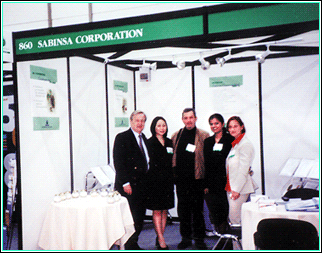
On April 24-26, 2001, Sabinsa participated in the In-Cosmetics exhibition and conference held in Düsseldorf, Germany. Associates from Sabinsa’s New Jersey office, Kavita Subramanian (Manager of New Business Development) and Alicia Kim (Sales/Marketing Associate) discussed and displayed products from Sabinsa’s cosmeceutical line.
Also, exhibiting at the show were Nordmann, Rassmann GmbH, Sabinsa’s agents for Germany, Austria, Hungary and Switzerland.
On the same date, Sabinsa exhibited at Vitafoods 2001 held in Geneva, Switzerland. Todd Norton (President & COO of Sabinsa) and Dr. Vladimir Badmaev (Vice President of Scientific & Medical Affairs) discussed products from Sabinsa’s nutritional and functional food lines.
SilbinolTM (Pterocarpus marsupium extract)
SilbinolTM is a trademark of Sabinsa Corporation. It is a standardized extract obtained from the Pterocarpus marsupium tree. It is beneficial in the maintenance of healthy blood sugar levels.
P. marsupium is a large deciduous tree which has a characteristic stout, crooked stem, widely spreading branches, and thick, yellowish-grey bark. It commonly grows in the central, western, and southern parts of India and in Sri Lanka. In Hindi, P. marsupium is known as Bibla (Vijayasar or Bijasar), and in English it is called Indian Kino.1
The antidiabetic effects of P. marsupium were well known in India long before pharmacological studies were undertaken. Diabetics in the rural areas of Chatisgarh (region of Madhya Pradesh) in India were said to feel better after drinking water from tumblers carved from the wood of P. marsupium or drinking water in which a piece of the tree’s wood had been immersed.2
Recent pharmacological investigations have shown that aqueous and alcoholic extracts of the bark and heartwood of P. marsupium have been administered with success to diabetic animal models.2-3 Similarly, tablets, granules, and decoctions containing P. marsupium (the heartwood identified as the plant part utilized in some articles.), alone or as multi-ingredient formulations, have also been successful in promoting beneficial blood sugar levels in diabetic humans.4-5
A phase 2, open trial was conducted with a decoction of P. marsupium by the Indian Council of Medical Research (ICMR) at 4 centers in India. P. marsupium was tested in 93 newly diagnosed, non-insulin dependent diabetes mellitus (NIDDM) patients for 12 weeks. The parameters used to evaluate the patients’ results were blood glucose levels and glycosylated hemoglobin (HbA1c). The main findings of the study were4:
- Of the three cardinal symptoms for diabetes, a marked reduction was observed for polyuria (the production of large volumes of urine). The other two symptoms, polyphagia (gluttonous excessive eating) and polydipsia (abnormally intense thirst), initially observed in 21 and 7 patients, respectively, disappeared in 14 and 7 patients, respectively within 12 weeks of treatment.
- Control of both fasting and postprandial blood glucose was achieved in 67 of 93 newly diagnosed or untreated NIDDM patients. Approximately 73% of these patients required a daily dose of 2 g of P. marsupium. Only 10% of the patients required a higher dose of 4 g per day, and this dose was well tolerated.
- No relationship was found between the dose of P. marsupium and the changes observed in the HbA1c levels. Only 7% of the patients attained control of HbA1c by week 12.
- None of the patients reported any side effects.
Pterostilbene (present in the bark and heartwood) and (-)-epicatechin (present in the bark) are reported to be the antidiabetic chemical constituents of P. marsupium.
SilbinolTM is prepared from the heartwood and bark of P. marsupium, and it is standardized for a minimum of 5.0% pterostilbene and a minimum of 0.01% (-)-epicatechin.

References
-
CHEMEXCIL (1992) Selected Medicinal Plants of India (A Monograph of Identity, Safety, and Clinical Usage) Tata Press Ltd. (Bombay, India), pages 259-260.
-
Saifi, A.Q. et al. (1971) J. Res. Ind. Med., 6(2), 205-207.
-
Apte, I.C. et al. (1988) Indian Drugs, 25(11), 461-463.
-
Indian Council of Medical Research (ICMR) (1998) Ind. J. Med. Res., 108, 24-29.
-
5. Kedar, P. and Chakrabarti, C.H. (1981) Maharashtra Med. J., 28(6), 165-169.








